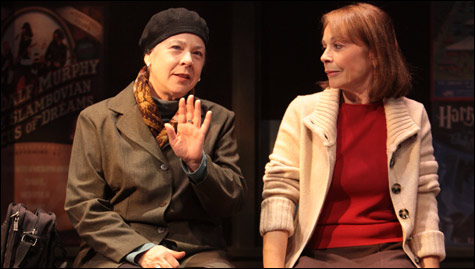
THIRD: Robin Pearson Rose and Maureen Anderman do well by Wendy Wasserstein’s flawed final work. |
Wendy Wasserstein might have chosen a lesser light in whose shadow to cast a play than King Lear. But the late author’s final work for the stage, Third (presented by the Huntington Theatre Company at the Boston University Theatre through February 3), refers to Shakespeare’s titanic tragedy, from its droll opening lecture to its academic dust-up over plagiarism to a scene near the end in which an addled old man battles the elements on a sidewalk “heath” before a New England bookstore. Third, of course, is not a titanic tragedy but a warm and pithy if too-pat comedy from the witty, chord-striking feminist who penned the 1989 Pulitzer winner The Heidi Chronicles. Wasserstein died of lymphoma in 2006, just months after the debut of this her dramaturgical swan song, into which she tried to pack a whole lot of what she was thinking and feeling, both on behalf of her own waning self and the generation of “uncommon women” she had come to represent. Is it any wonder, then, that the work — seen here in a crisp, humane, if somewhat magisterial staging by Richard Seer — seems at once thin and overstuffed?
Born in 1950, Wasserstein created a series of smart, funny, romantically challenged boomer heroines, from the Mount Holyoke posse of Uncommon Women and Others to art historian Heidi Holland, who in the mid ’80s wonders where all the feminists have gone. Third brings pioneering liberal English professor Laurie Jameson, who spends the 2002-’03 academic year hot under the collar because of menopausal flushes and ire at the Bush administration. When confronted by happy-go-lucky (and possibly Republican) Midwesterner and college wrestler Woodson Bull III, the “Third” of the title (though it also refers to the final third of one’s life), she at once demonizes the aspiring sports agent as a “walking red state.” And when he turns in a masterfully written psychosexual interpretation of King Lear, she brings him up on plagiarism charges — less because he fails to hold with her radical interpretation, which declares Goneril and Regan “right,” Cordelia a wimp, and the mad monarch himself a foolish old narcissist, than because, as her perceived political opposite, he can no more have a brain than L. Frank Baum’s Scarecrow.

That’s the main plot, but others intrude. Laurie’s colleague and best friend, the twinklingly shrewd Nancy Gordon, is going through cancer torture. Her childlike if cantankerous father has fallen victim to Lear-like Alzheimer’s. And her daughter, a freshman at Swarthmore who happens onto Woodson Bull III and his side of the story, condemns her mother as cloistered, rigid, and “limited.” Moreover, professorial superstar Laurie has left her political-scientist husband so far behind that he’s become Mr. Cellophane with a PhD. Both the cancer and the Alzheimer’s are visitors from Wasserstein’s own life — rooted in her own, her sister’s, and her father’s experience — and, in hindsight, one understands why she was in such a rush to write about them. But the way in which everything jigsaws together is, for all of Wasserstein’s compassion and bristling intellectual jocularity, both sentimental and schematic. Yet the comedy tugs at your heartstrings even as you point a finger at its flaws.
When Third debuted, Dianne Wiest brought (by most accounts) an ameliorative softness to Laurie (who, echoing Heidi Holland, goes all wistful in the midst of a second-act lecture). At the Huntington, Maureen Anderman plays her more as written: a decent person with a hard, ironic edge. There are also enjoyable performances by Robin Pearson Rose as cancer survivor Nancy, who’s determined to enjoy the third of her life she had expected to be a no-show, and Halley Feiffer, who brings a tart goofiness to Laurie’s questioning daughter. But as Woodson Bull III, Graham Hamilton is too benign to be seen, even by Angela Davis crossed with Hillary Clinton, as an avatar of the Bush administration.
The stakes are higher among the academics of Copenhagen (presented by the American Repertory Theatre at the Loeb Drama Center through February 3). British writer Michael Frayn’s shifting meditation on the mysterious 1941 meeting between Danish physicist Niels Bohr, who went on to work at Los Alamos, and Werner Heisenberg, the Bohr acolyte who headed Hitler’s nuclear-energy program, in the Nazi-occupied city of the title won the London Evening Standard Award for Best Play in 1998 and followed that up with a 2000 Tony. The ART, which does not often catch trickle-down from Broadway, has revived the heady work, set designer David Reynoso crowning it with a Calderesque atom on which electrons blink and circle like cars on a roller coaster. Scott Zigler is at the helm of the production, whose three capable players move in circles or along axes, more slowly than those zooming electrons but in similar patterns, offering an intelligent, flaringly emotional rendering of Frayn’s scientifically scored symphony of memory, perception, misperception, and the uncertainty, here transferred from quantum physics to “a strange new quantum ethics,” for which Heisenberg was famous.